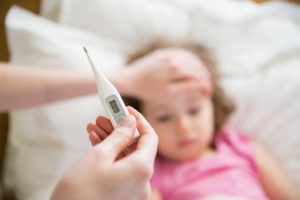Three-day fever is a harmless viral disease that affects almost exclusively infants and young children worldwide. Three-day fever is also known as “Roseola infantum”. Equally common are names such as “exanthema subitum” or “the sixth disease”. Children’s diseases of this kind are usually harmless. But nevertheless, if your child is suffering from fever, you should pay special attention to it.
The Three-Day Fever – Feared By Many Parents
The 3-day fever is caused by the herpes viruses of types 6 and 7. The disease is transmitted by the so-called droplet infection. This means that the 3-day fever is primarily transmitted via droplets of secretion in the air that the person exhales as well as via saliva contact. It takes about two weeks for the fever to break out after the first contact with the virus.
When Does A Fever Start – And Other Questions
If your child has been ill with a three-day fever once, he or she will never get it again in his or her life. This is because after the fever is over, he or she is protected against another infection for life. Children between the ages of six and 15 months can be particularly affected by three-day fever. According to current statistics, at the age of two years, no less than almost 97 percent of all babies or young children are infected.
- Also Interesting:
- The best crawling tunnels
- Recommended climbing walls for the nursery
- The best toys for children
The Symptoms Of 3 Days Fever
The signs of 3-day fever are not always recognizable at first sight. In many cases, the fever progresses without the typical signs. In fact, often hardly any symptoms are recognizable when children are infected with a 3-day fever. Then again, there are young patients in whom the 3-day fever manifests itself by a body temperature of more than 40 degrees Celsius. Similar to the fever that adults can have, a three-day fever can last anywhere from three to five days. At what point does one have a fever and what is so dangerous about a three-day fever – you can learn this and more in this guide article.
Why Is 3-Day Fever Also Called “Sixth Disease”?
There are several names for the three-day fever. The name “sixth disease” seems a little mysterious in this context. The reason for the name is relatively unspectacular. Three-day fever is therefore also called the “sixth disease” because it is the sixth in a series of known or common childhood diseases, which are characterized, among other things, by a similar skin rash. In this regard, the other diseases that babies and young children often suffer from are measles, scarlet fever, ringworm, mumps and rubella.
These are the herpes virus 6 or HHV-6B or the herpes virus 7, which is considered the main cause of three-day fever. The latter is an enveloped DNA virus, which is assigned to the Herpesviridae family.
Characteristic Symptoms Of 3-Day Fever
– The fever appears very suddenly. It comes “overnight”, so to speak.
– One of the first symptoms is a high body temperature of over 40 degrees Celsius.
– The fever can last from three to five days.
– Sometimes no discomfort is felt.
– The nose runs.
– The young patient coughs a lot.
– Some infants and young children suffer from so-called febrile convulsions. (Febrile = feverish or febrile)
– Often the lymph nodes are slightly swollen.
– Loss of appetite often accompanies the 3-day fever.
– Sometimes diarrhea and vomiting occur.
– In rare cases, there is mild to severe swelling of the eyelids.
– After the body temperature has decreased, a so-called exanthem appears. This is a pink maculopapular skin rash that appears especially on the neck as well as on the trunk. After about two hours, the skin condition subsides. On the other hand, complete regulation of the rash may take up to two days in some children. The three-day fever ends when the exanthema subsides.
Notice:
It is also quite possible that no rash will show.
Sometimes the rash appears more as a small, reddish skin change that can spread very rapidly within a few hours. The abdomen, back, chest and extremities are predominantly affected. The rash is also sometimes seen on the face and scalp. Those affected rarely talk about itching.
– In babies with three-day fever, it is conceivable that the fontanel is tense or slightly bulging. Once the fever has subsided, the children are usually still very querulous and tired over a period of several days.
At What Point Does One Have A Fever – You Should Know!
Although children’s illnesses such as these are very harmless in most cases and sometimes even run symptom-free, caution is advised. It is also possible that complications may arise during the course of the disease. The herpes virus can cause meningitis, an inflammation of the meninges. It can attack the brain tissue or cause liver inflammation – hepatitis.
This Is How You Can Fight The 3 Day Fever In Your Child:
The pediatrician usually detects illness with the 3-day fever through a test called viral isolation, or the detection of antibodies in the blood. The symptoms are usually relieved with antipyretics. These are fever-reducing or fever-protecting drugs given primarily with analgesics or a pain reliever.
Infants and young children are not the only ones who can come down with a three-day fever. The fever can also affect adults. If febrile convulsions occur, experience has shown that this has a very disturbing and frightening effect on the relatives. The fever, which can also affect adults, and in which sometimes severe febrile convulsions occur, is nevertheless relatively harmless. Thus, a febrile convulsion usually resolves after a few minutes. In children, no permanent damage remains after such a convulsion.
It is not possible to prevent a three-day fever. So far, there is no vaccination against the fever. If the temperature is too high and the body is weakened too much as a result, fever is lowered with medication. Any febrile convulsions can usually be treated well with antispasmodic drugs.
– Sufficient fluid intake is important. As body temperature rises, the child’s body secretes more body fluid through the skin. It is best to give your baby small amounts to drink at short intervals. Larger amounts of fluid could possibly trigger nausea and weaken the body even further. Depending on the age of the sick child, unsweetened fennel or anise tea, diluted fruit juices or tap water is suitable.
Important:
If your baby does not drink enough fluids, there is a risk of dehydration. It often helps if the pediatrician temporarily supplies fluid in the form of an infusion via the vein.
– Make sure that your baby wears light clothing now. Only then is it possible for the body to release heat through the surface of the skin, thus helping to reduce the fever?
– Regulate the room temperature to about 18 to 19 degrees Celsius. In this way, your child’s body will not heat up additionally.
– Calf wraps or cooling compresses can be very helpful in lowering the fever.
Tip:
Adults relatively rarely get sick with a three-day fever. This is because they are immune due to a probable previous illness in childhood. The situation is different, however, if HIV disease is present or if the immune system is weakened for other reasons. Under these circumstances, a new illness is not uncommon. Therefore, special caution is required for pregnant women, because their immune system is sometimes very weakened by the hormonal changes in their body and therefore vulnerable.
At the first signs of fever, adult women expecting a baby should therefore consult their trusted doctor immediately. Expectant mothers with corresponding symptoms can contact their midwife if they have any questions.
Conclusion:
Three-day fever is probably the most common illness in infants and young children. Adults can also be affected by fever. However, this is rarely the case or only if they have a weakened immune system anyway.
Three-day fever is usually harmless, but may very well be accompanied by serious symptoms or complications. Parents are therefore well advised to consult their pediatrician if their child is ill with three-day fever. If necessary, the pediatrician will prescribe antipyretic medication, which parents can supplement with soothing home remedies such as cooling compresses or calf wraps.











1 thought on “The Three-Day Fever – That Is Why It Is So Dangerous”